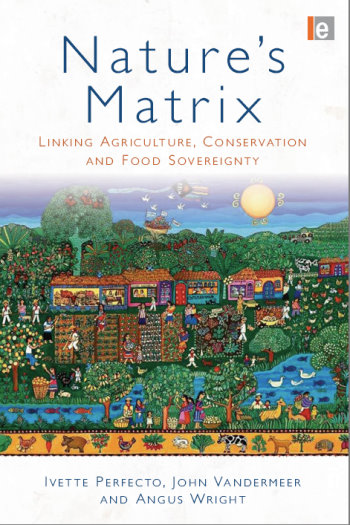Most people who are trying to change the world stick to one area, for example they might either work to preserve biodiversity in rainforests or do social justice with poor farmers. But Dr. Ivette Perfecto was never satisfied with having to choose between helping people or preserving nature. Professor of Ecology and Natural Resources at the University of Michigan and co-author of the recent book Nature’s Matrix: The Link between Agriculture, Conservation and Food Sovereignty, Perfecto has, as she says, “combined her passions” to understand how agriculture can benefit both farmers and biodiversity—if done right.
Born in Puerto Rico, and working primarily in Central America, Perfecto has been struck by her research that shows agricultural landscapes are capable of containing as much biodiversity—in some cases even more—than rainforests, while continuing deforestation and fragmentation was leading to an untenable situation.
“In the vast coffee landscapes of Costa Rica the biodiversity of insects rivaled that of natural forests at similar elevations, and the isolated patches of rain forest in which we were working in Nicaragua were obviously not sufficient to maintain even the reduced species diversity that existed there. A new paradigm was needed, clearly,” she told mongabay.com in an interview.
|
Ivette Perfecto. Photo courtesy of Ivette Perfecto. |
That new paradigm for Perfecto was combining agroecology farming practices with food sovereignty politics to create a better, more sustainable world.
Agroecology at its root means that farmers work with nature rather than against it.
As Perfecto says, “agroecology is the application of ecological principles to agricultural production, including the activities of the humans involved. Agroecology normally does not include the use of pesticides or excessive use of artificial fertilizers, and is most commonly practiced by small-scale farming operations.”
The practice of agroecology, as well as organic farming, not only preserves biodiversity, but also rivals industrialized farming in its output.
“A variety of studies have shown convincingly that organic agriculture is at least as productive as industrial agriculture and according to FAO data, the smaller the farm the more productivity. In other words, if you want to increase production the most efficient way to do so is to break up the mega farms, distribute the land to small-scale farmers and provide training in agroecology,” Perfecto says.
While researchers don’t know exactly why food production is equal to or even higher on smaller farms rather than big industrialized farms, Perfecto says that “it seems to me that people that own or manage those very large farms know very little about the ecology of their farms and thus are not maximizing the potential of the land. Just think how much land is wasted every time a large combine engine, the size of a small house turns a corner!'”
Given agroecology’s effectiveness both for producing food and preserving biodiversity, Perfecto believes that the next step is a social one: breaking the corporate hold on food production by pushing food sovereignty, which is “the right not only to be well-fed, but also the right for a community to decide on the social and ecological conditions under which their food is produced,” according to Perfecto.
But, how does one go about achieving food sovereignty?
“First, break up large farms and redistribute them to the more efficient small-scale producers. Second, improve production with more organic and agroecological methods, which could be aided dramatically with an investment of research and development monies,” Perfecto says, adding that she would like to see the world’s big conservation groups “connect more with small-scale agriculturalists and join in with the movement for land reform and food sovereignty the world over.”
In a May 2010 interview mongabay.com spoke with Ivette Perfecto about agroecology and food sovereignty, but also about the global food crisis, the green revolution, and the belief that conservation means vast forming protected areas.
INTERVIEW WITH IVETTE PERFECTO
Mongabay: What is your background?
Ivette Perfecto: I was born and raised in Puerto Rico, but did my graduate training at the University of Michigan. In Puerto Rico I was always fascinated by nature, but intensely concerned about social justice. It was in graduate school that I discovered how to put those two passions together.
Mongabay: You have a new book out called Nature’s Matrix: The Link between Agriculture, Conservation and Food Sovereignty which fits very well with the following interview. What led you to write the book?
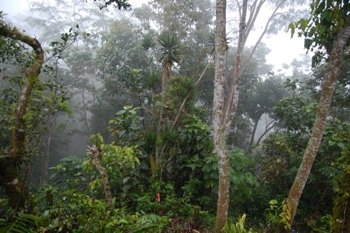 Shaded coffee in Mexico. Photo by: Ivette Perfecto. |
Ivette Perfecto: Along with my colleague (and partner) John Vandermeer, we had been working on some ecological issues associated with rain forest preservation on the one hand (mainly in Nicaragua) and with coffee production on the other (mainly in Costa Rica). It rapidly came to our attention that from a wholly ecological point of view, the standard vision of conservation was not only immoral and unethical (which had been many times reported before), but really did not make sense from an ecological perspective either. In the vast coffee landscapes of Costa Rica the biodiversity of insects rivaled that of natural forests at similar elevations, and the isolated patches of rain forest in which we were working in Nicaragua were obviously not sufficient to maintain even the reduced species diversity that existed there. A new paradigm was needed, clearly.
The issue came to a head when I organized a special session at the Latin American Scholars Association talking about the relationship between forest preservation and social justice. I originally organized that session because I had come to be surprised at how little the ecological view was actually appreciated among those concerned with social justice. Yet the perspective we had developed from our ecological work in Costa Rica, Nicaragua and Mexico showed clearly that an interpretation based on modern ecological theory reached the same general conclusions that had been promoted by social justice advocates for so many years.
One of the participants at that conference was Angus Wright, who analyzed the situation from the perspective of an environmental historian. He and I and John got to talking and it seemed like the time was ripe to try and put all of this together in a book. “Nature’s Matrix” thus emerged.
AGRICULTURE AND CONSERVATION
Mongabay: What is agroecology?
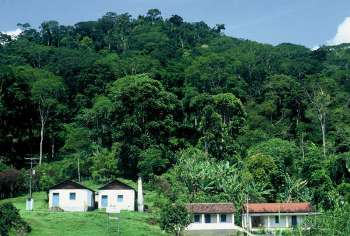 Cobruca (shaded) cacao in Bahia, Brazil. Photo by: Angus Wright. |
Ivette Perfecto: Agroecology is the application of ecological principles to agricultural production, including the activities of the humans involved. Agroecology normally does not include the use of pesticides nor excessive use of artificial fertilizers, and is most commonly practiced by small-scale farming operations.
Mongabay: Can agricultural and biodiversity ever be in harmony, or is one always up and the other always down?
Ivette Perfecto: It is important to distinguish between different forms of agriculture. Some agriculture is friendly to conservation in that it contains a large amount of biodiversity and/or provides a high quality matrix through which organisms migrate among different habitat types.
Mongabay: Why is migration so vital to preserving the world’s biodiversity?
Ivette Perfecto: Most populations live in a metapopulation context, experiencing local extinctions as a normal part of the biological dynamics of the world. This is not so important when you have a large swath of natural habitat since when a patch of some organism goes extinct that patch is normally colonized later by organisms from another patch. When the natural habitat becomes fragmented, the extinctions don’t change (in fact they may become more intense) so the ability to recolonize areas that had undergone a local extinction becomes crucial. Without the potential to migrate from habitat fragment to habitat fragment a population will go completely extinct.
Mongabay: How are nature reserves a ‘failed strategy’ when it comes to saving the world’s biodiversity?
Ivette Perfecto: First nature preserves represent only a small fraction of the area in which biodiversity is located. Some very high proportion (perhaps greater than 50 percent) of the world’s biodiversity lives outside of preserved areas. Second, local extinctions are natural and inevitable, so ignoring the matrix (which the nature reserve strategy effectively does) condemns most of the species to global extinction.
Mongabay: Aren’t there some species that require large nature reserves to survive?
Ivette Perfecto: This is true. And some require reserves so large that they will probably not survive at all in this world. But the classic conservation agenda does not really recognize this fact.
Mongabay: How would looking at combining agricultural and conservation allow people to begin to see and understand less ‘charismatic’ species?
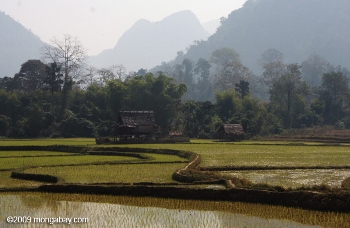 Rice fields in Luang Prabang province in Laos. Photo by: Rhett A. Butler. |
Ivette Perfecto: Not sure how to answer this except to note that one cannot see and understand what is not there. A pesticide-drenched rice paddy contains very little biodiversity to be seen by anyone. On the other hand it is important to realize that those less charismatic species provide important ecosystem services, like pollination, decomposition and nutrient cycling, pest control. All of these processes are important for sustainable agriculture. I will also recommend people to carry a good hand-held lens next time they go to a garden or a forest. Some tiny creatures are spectacularly beautiful!
Mongabay: You have argued that increased intensification of agriculture actually creates more deforestation rather than less as would be expected. Why is this?
Ivette Perfecto: This is not always the case but empirical studies suggests that it is more frequently the case that with agricultural intensification there is more not less deforestation. What happens is that as intensification increases in one area there is a tendency for people to move to that area or open more areas to take advantage of those intensification activities.
Mongabay: How would you like to see the big conservation organizations proceed?
Ivette Perfecto: To connect more with small-scale agriculturalists and join in with the movement for land reform and food sovereignty the world over.
FOOD CRISIS
Mongabay: Would you say the food crisis occurring in many countries worldwide is a problem of production or distribution?
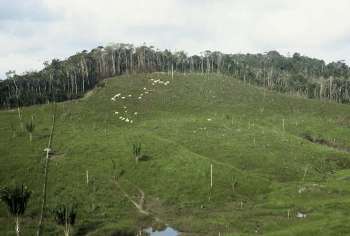 Cattle ranch in Bahia, Brazil. Photo by: Angus Wright. |
Ivette Perfecto: There is little doubt that distribution is the problem today.
Mongabay: Africa has not increased its food yields as other parts of the world have. Implementation is beginning on a ‘green revolution’ in Africa similar to those undertaken in Mexico and India. Is this the right way to proceed?
Ivette Perfecto: Depends on what you want. The original green revolution was good for a small number of farmers and especially good for pesticide manufacturers and fertilizer companies (as well as contractors to build dams and irrigation canals, farm machinery and the like). It was certainly bad for the thousands of small-scale farmers who could not afford the inputs and thus became landless and finally urban slum-dwellers. If the same thing is repeated in the new green revolution in Africa, I see no reason to expect anything different.
Mongabay: Many have said that there is not enough arable land for smaller scale organic farms to feed the world. Is this true—why or why not?
Ivette Perfecto: There is less debate on this topic any more. A variety of studies have shown convincingly that organic agriculture is at least as productive as industrial agriculture and according to FAO data, the smaller the farm the more productivity. In other words, if you want to increase production the most efficient way to do so is to break up the mega farms, distribute the land to small-scale farmers and provide training in agroecology.
Mongabay: You have said that larger farms are actually less efficient and therefore less productive. Can you explain this?
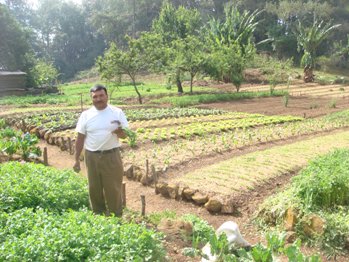 A small farm in the Huitepec close to San Cristobal de las Casas, Chiapas, Mexico. Photo by: Ivette Perfecto. |
Ivette Perfecto: This is what the data say. It is well know amongst agricultural economists, so much so that they even have a name for it: “the inverse size productivity relationship.” This relationship was first pointed out by Nobel laureate Amartya Sen, from India. Exactly why this is the case is a matter of speculation, but it seems to me that people that own or manage those very large farms know very little about the ecology of their farms and thus are not maximizing the potential of the land. Just think how much land is wasted every time a large combine engine, the size of a small house turns a corner! Small scale farmers typically know every centimeter of their farm and are able to take advantage of small ecological idiosyncrasies to maximize productive potential. I guess you can say that small-scale farmers practice a traditional form of “precision agriculture.”
Mongabay: Given that the world’s population continues to expand, how can the human population be fed going forward?
Ivette Perfecto: First, break up large farms and redistribute them to the more efficient small-scale producers. Second, improve production with more organic and agroecological methods, which could be aided dramatically with an investment of research and development monies.
FOOD SOVEREIGNTY
Mongabay: What is food sovereignty? Why does it matter?
Ivette Perfecto: This is a concept invented and developed by the international umbrella organization “Via Campesina”. It basically challenges the idea of food security, which carries with it a paternalistic and potentially oppressive connotation (after all, one of the most “food secure” places in the world is a prison). Rather, the right not only to be well-fed, but also the right for a community to decide on the social and ecological conditions under which their food is produced, are key elements in the food sovereignty movement.
Mongabay: What stands in the way of this creating this system?
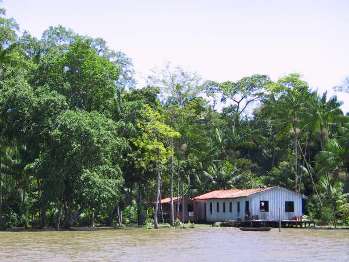 River agroforestry in Amazonas, Brazil. Photo by: Angus Wright. |
Ivette Perfecto: Many political actors, from corrupt politicians in the global south to traditional politicians in the north subservient to “big Ag” (large agricultural corporations), gain a great deal from the way the current food system is operating. These political/economic actors exert an enormous influence on policy the world over.
Mongabay: How is the political struggle for food sovereignty part of the struggle for biodiversity?
Ivette Perfecto: If, as we argue, the struggle for biodiversity is a landscape-level activity, the type of agriculture that goes on in that landscape becomes crucial, especially the creation of a high-quality matrix, which, we argue, is most likely to be done by small-scale agriculturalists engaged in agroecological production techniques.
Mongabay: Okay, I have to ask, what’s your idea of the perfect meal?
Ivette Perfecto: Grass-fed beef or free range chicken, organic fruits and vegetables, all produced locally and with a pint of locally brewed beer.
Related articles
Could agroforestry solve the biodiversity crisis and address poverty?, an interview with Shonil Bhagwat

(09/24/2009) With the world facing a variety of crises: climate change, food shortages, extreme poverty, and biodiversity loss, researchers are looking at ways to address more than one issue at once by revolutionizing sectors of society. One of the ideas is a transformation of agricultural practices from intensive chemical-dependent crops to mixing agriculture and forest, while relying on organic methods. The latter is known as agroforestry or land sharing—balancing the crop yields with biodiversity. Shonil Bhagwat, Director of MSc in Biodiversity, Conservation and Management at the School of Geography and the Environment, Oxford, believes this philosophy could help the world tackle some of its biggest problems.
Turning to the matrix: a more accurate way to predict extinction

(04/14/2010) According to most conservationists the globe is striding into the midst of the Sixth Mass Extinction. Species populations worldwide are dropping and in many cases species are vanishing all together due to pollution, climate change, poaching and hunting, overconsumption, invasive species, and exotic diseases, but no threat proves more pervasive and devastating for the world’s species than habitat loss.
How free trade has devastated Africa’s farmers and poor
(02/15/2010) A push in the mid-1980s for Africa to embrace free trade to aid it economies backfired in many of the continent’s poorest countries, argues a new study in the Proceedings of the National Academy of Sciences (PNAS). Africa was pushed to rollback government involvement in development and instead to rely on the private sector: government services shrunk, cash crops were pushed over staples, while tariffs and subsides were abolished. The insistence on free trade was meant to spur economic growth, but instead undercut traditional agricultural systems that had worked for centuries, eventually leading to a food crisis, which left millions hungry, led to multiple food riots, and destabilized governments.
Chinese farming practices are acidifying soils
(02/11/2010) A new study in Science shows that farming practices in China are acidifying the nation’s soils and threatening long term productivity at a time when food concerns worldwide have never been higher. The culprit is the increasing use of nitrogen fertilizer.
Commodity trade and urbanization, rather than rural poverty, drive deforestation

(02/07/2010) Deforestation is increasingly correlated to urban population growth and trade rather than rural poverty, suggesting that measures proposed to reduce deforestation will be ineffective if they fail to address demand for commodities produced on forest lands, argues a new paper published in Nature GeoScience.
Will it be possible to feed nine billion people sustainably?

(01/28/2010) Sometime around 2050 researchers estimate that the global population will level-out at nine billion people, adding over two billion more people to the planet. Since, one billion of the world’s population (more than one in seven) are currently going hungry—the largest number in all of history—scientists are struggling with how, not only to feed those who are hungry today, but also the additional two billion that will soon grace our planet. In a new paper in Science researchers make recommendations on how the world may one day feed nine billion people—sustainably.
Americans throw away enough food every year to feed 200 million adults
(11/30/2009) The amount of food Americans throw away has risen by approximately 50 percent since 1974 according to a new study in PLoS ONE. American now waste on average 1400 calories per person everyday, equaling 150 trillion calories a year nationwide. Considering that the average person requires approximately 2,000 calories a day, this means that the US could feed over 200 million adults every year with the food that ends up in the trash. Currently, the UN estimates that one billion people—an historical record—are going hungry worldwide.
200 million more people going hungry
(10/26/2009) The war on hunger is becoming a rout—and we’re losing. The UN World Food Program (WFP) announced today that during the last two years 200 million more people are going hungry.
Guatemala latest country to declare food crisis: nearly half a million families face food shortages
(09/10/2009) The President of Guatemala, Alvaro Colom, has announced a “state of public calamity” to tackle food shortages throughout the Central American nation. The failure of bean and corn crops from drought, which cut the yields of these staple crops in half, has brought the crisis to a head. In addition, prime agricultural land in Guatemala is often used to grow export crops like coffee and sugar rather than staples.
Farmers have poor understanding of role of wildlife in protecting crops
(08/10/2009) Environmental conservation depends, to a large degree, on public acceptance. Understanding people’s opinions on ecosystems and wildlife can be very helpful in designing programs that aim to benefit both the environment and society. A new study, published in Tropical Conservation Science, interviewed organic shade-coffee farmers in Cuetzalan, Mexico, to understand how they perceive the wild animals that live in their fields, as well as their knowledge of the ecological roles these species play in maintaining ecosystem services.
Meeting food and energy demands by mid-century will be a challenge, says report
(06/25/2009) Meeting food and energy demands in a world where human population is expected to reach 9 billion by mid-century will require a range of approaches that increase the sustainability of agricultural production, reports a new assessment from Deutsche Bank’s Climate Change Advisors (DBCCA).
What is the crop productivity and environmental impact of too much or too little fertilizer?

(06/18/2009) While the use of synthetic fertilizer has greatly increased agricultural production globally—helping to feed a global population that is not slowing down—it has brought with it high environmental costs. Fertilizer runoff has polluted many coastal regions creating ‘dead zones’ where the ocean is starved of oxygen by the influx of nitrogen. Synthetic fertilizers have also polluted the air with ammonia, and sent emissions of nitrous oxide into the atmosphere, contributing to global warming.
